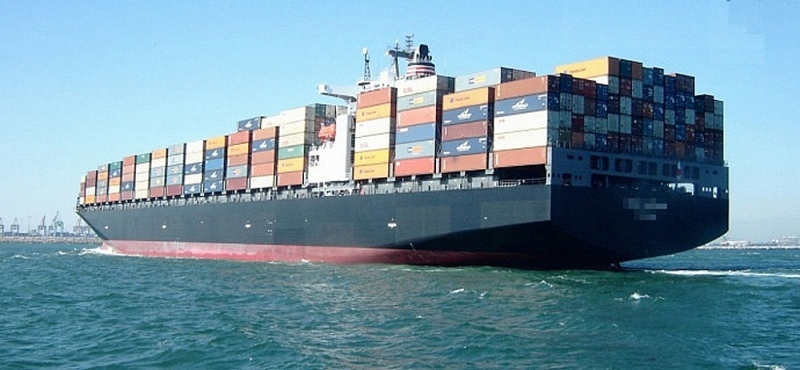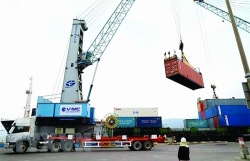 |
| Illustration |
Reduce quantity of goods, plunge freight rates
According to the Vietnam Maritime Administration, the total volume of goods through Vietnam’s seaports in 2022 increased by about 4% compared to 2021. In which, exports reached 179 million tons, down 3%; imported goods reached more than 209 million tons, down 2%; and domestic cargo reached 342.8 million tons, up 12% compared to 2021. The volume of container cargo through seaports in 2022 reached 25.09 million TEUs, up 5%.
The Russia-Ukraine war that broke out in early 2022 caused a supply shock, pushing up energy and commodity prices. Consumer confidence was hit hard by high inflation in importing countries. Moreover, consumer spending gradually shifted from goods to services in the post-Covid era, weakening the demand for goods transported by containers.
Besides, inventories remained high as retailers boosted the import of goods early to avoid the risk of delayed shipping. The peak season did not take place in the second half of 2022 and transportation demand dropped significantly towards the end of the year. The reduced demand improved port congestion, which has released a significant amount of vessel supply to the market.
Weak demand and increased supply of ships made the shipping industry no longer benefit from the freight rate factor. According to data from SSI Research, freight rates have decreased by 77% compared to the end of 2021 and by 80% from the peak in September 2021. Similarly, charter rates also decreased from the third quarter of 2022 and by the end of the year were down 77% from the peak.
Domestically, the supply of ships also increased significantly after a large number of vessels that could not renew their leases returned to the domestic market. This caused domestic freight rates to fall deeply to the low of 2020 and down 50% from the peak.
For bulk freight, the Baltic Dry Index continued to drop 32% at the end of 2022, at 1,515, representing a 73% drop from its October 2021 peak. In 2022, the demand for dry cargo transport was mainly affected by the decrease in grain production of Ukraine, while iron ore demand fell due to sluggish construction activity in China, along with weak demand from Europe and Japan.
Meanwhile, liquid freight has warmed up thanks to changes in market structure. Since the outbreak of the Russian-Ukrainian war, demand for tankers increased as sanctions targeting Russia’s energy sector caused the world to seek energy supplies from other markets, increasing demand for petroleum transportation. Simultaneously, the supply of liquid cargo ships was limited as new orders were still low. As a result, the Baltic Dirty Tanker Index and the Baltic Clean Tanker Index were up 138% and 171% respectively from the end of 2021, even higher than the 2020 peak.
Dividend profit
The above developments in the market created a divergence in the profit picture of shipping lines in 2022. Specifically, Hai An Transport and Loading and Unloading JSC (HAH) recorded a net profit in 2022 of VND1,051 billion, nearly double the result in 2021.
Meanwhile, benefiting from the liquid cargo transportation market, VIPCO Petroleum Transport JSC reported a sudden profit of more than VND246 billion, 25 times higher than in 2021.
According to the explanation of VIPCO’s management, in the fourth quarter of 2022, the company recorded income from the liquidation of the Petrolimex 10 vessel, bringing in a net income of VND217.7 billion. Along with that, the increase in the world and regional freight rates brought high profits to the company.
Also mainly transporting oil, PetroVietnam Transportation Corporation (PVTrans) reported a consolidated profit of VND1,161 billion, up 39%. Accordingly, the increased profit mainly came from the efficiency of new investment vessels.
In contrast, the consolidated after-tax profit in 2022 of Vietnam Shipping JSC recorded a decrease of 7%, to VND488 billion. At Vietnam National Shipping Lines (MVN), the profit in 2022 also decreased by 23% compared to 2021, reaching VND2,566 billion, although revenue increased by nearly 8%, at VND14,350 billion.
According to the company’s management, after a strong recovery in the first half of 2022, the shipping market fell into decline since the third quarter, making the operation of the shipping sector not keep the increasing momentum as in the first months of the year. Besides, according to Nguyen Canh Tinh, General Director of Vinalines, a loss of VND627 billion in joint ventures and an increase in selling and administrative expenses of VND337 billion were the two main reasons for the decline in profit in 2022.
According to analysis by SSI Research, consumer demand will continue to be weak in 2023 amid high inflation. Additionally, clearing inventory takes at least two quarters, and transportation demand is expected to recover from the second half of 2023 to prepare for the peak year-end shopping season. China’s reopening and resumption of international flights is a significant positive for the industry.
Meanwhile, the supply of new-built ships added to the pressure. According to Clarksons, the total volume of new construction orders accounts for 26.3% of the existing fleet. In addition, the amount of ship supply released when the port congestion was resolved may create more oversupply pressure on the transport market. Accordingly, experts of SSI Research estimated that the downtrend in freight rates would continue in the first half of 2023 and recover slightly in the second half of the year if demand increases.
In that context, container shipping and logistics companies will be most affected due to weak demand and increased supply, but output is expected to recover in the second half of 2023 when demand picks up again. Oil and gas transport companies participating in the charter market can benefit from stable tanker demand in the short to medium term, while those operating in the spot market may experience sharp fluctuations in freight rates as observed since the beginning of the year. The bulk shipping segment could benefit from the reopening of China.
 | Shipping lines do not transparently list freight rates VCN – The Vietnam Maritime Administration has just reported to the Ministry of Transport the results of … |
Sharing the same forecast, MVN gives the scenario of consolidated revenue in 2023 at VND13,354 billion, profit before tax of VND2,330 billion, down 7% and 9% respectively compared to the results in 2022. Similarly, although the results in 2022 were positive, HAH’s 2023 production and business plan also sets out a series of reduction targets compared to 2022. In which, the total output is expected to decrease by nearly 13%, to 874,000 TEU; revenue decreased 16% to VND2,698 billion and profit after tax of the parent company decreased by 64%, to only VND300 billion.
